Headspace and Community Services: Engagement Models and Theory
VerifiedAdded on 2023/04/21
|18
|1724
|202
Report
AI Summary
This report provides an overview of Headspace, an Australian organization focused on youth mental health, detailing its community engagement models, key components, and theoretical approaches. It highlights Headspace's mission to support young people aged 12 to 25 facing depression, anxiety, and substance abuse issues. The report examines the organization's use of community context and collaborative planning, community intervention, and strategies for community and system change. Key components of community engagement, including users and beneficiaries, advisors, management, decision-makers, and service deliverers, are discussed. The psychodynamic theory is identified as a central theoretical approach used by Headspace to understand and address behavioral issues. The report concludes that Headspace plays a significant role in social work in Australia by increasing access to mental health services for young people and effectively managing community engagement components.

Community Services Work
Paraphrase This Document
Need a fresh take? Get an instant paraphrase of this document with our AI Paraphraser
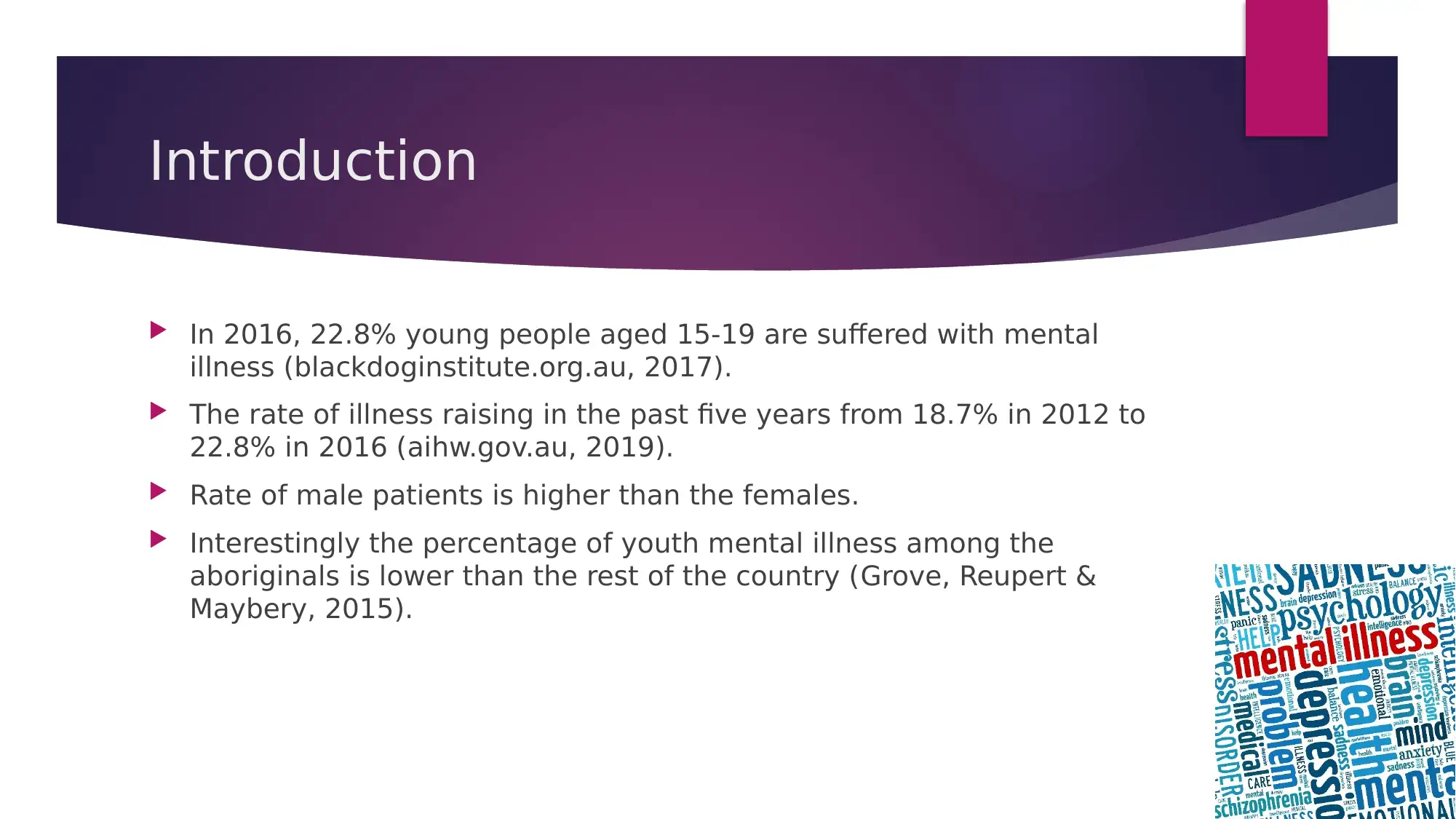
Introduction
In 2016, 22.8% young people aged 15-19 are suffered with mental
illness (blackdoginstitute.org.au, 2017).
The rate of illness raising in the past five years from 18.7% in 2012 to
22.8% in 2016 (aihw.gov.au, 2019).
Rate of male patients is higher than the females.
Interestingly the percentage of youth mental illness among the
aboriginals is lower than the rest of the country (Grove, Reupert &
Maybery, 2015).
In 2016, 22.8% young people aged 15-19 are suffered with mental
illness (blackdoginstitute.org.au, 2017).
The rate of illness raising in the past five years from 18.7% in 2012 to
22.8% in 2016 (aihw.gov.au, 2019).
Rate of male patients is higher than the females.
Interestingly the percentage of youth mental illness among the
aboriginals is lower than the rest of the country (Grove, Reupert &
Maybery, 2015).

Brief of the organisation
Funded by the Department of Health and Ageing under the Youth
Metal Health Initiative program
Headquarters of the organisation is in Melbourne, Victoria and the
organisation has over 100 centres across the country (Goodyear et
al., 2015).
Founded by Professor Patrick McGorry in 2006, the organisation is
flourishing in successfully in Australia with offline and online methods
of services.
Headspace delivers supports and services to the young people aged
from 12 to 25 years in order to reduce depression, anxiety, stress and
alcohol and illegal substances related issues (Vigo, Thornicroft &
Atun, 2016).
Funded by the Department of Health and Ageing under the Youth
Metal Health Initiative program
Headquarters of the organisation is in Melbourne, Victoria and the
organisation has over 100 centres across the country (Goodyear et
al., 2015).
Founded by Professor Patrick McGorry in 2006, the organisation is
flourishing in successfully in Australia with offline and online methods
of services.
Headspace delivers supports and services to the young people aged
from 12 to 25 years in order to reduce depression, anxiety, stress and
alcohol and illegal substances related issues (Vigo, Thornicroft &
Atun, 2016).
⊘ This is a preview!⊘
Do you want full access?
Subscribe today to unlock all pages.

Trusted by 1+ million students worldwide
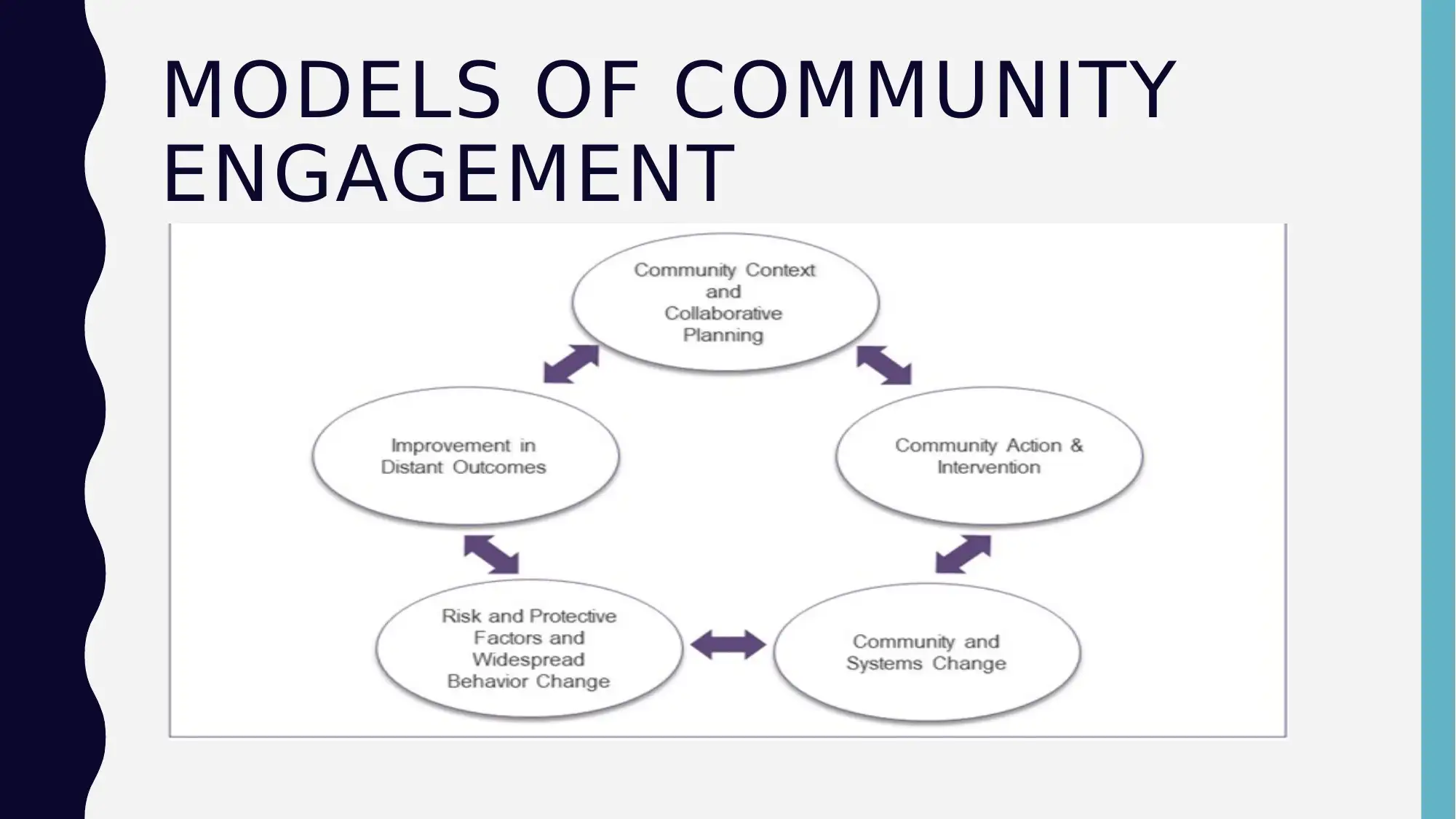
MODELS OF COMMUNITY
ENGAGEMENT
ENGAGEMENT
Paraphrase This Document
Need a fresh take? Get an instant paraphrase of this document with our AI Paraphraser

MODELS OF COMMUNITY ENGAGEMENT
Community context and collaborative planning
It is important for Headspace to identify the problem in a specific community or the entire
region and procuring better action plan to deal with the process.
It can be argued that the role of the community context is to figure out the problems
related to the community and prioritise it based on the significance of the social issues
(Moffat & Zhang, 2014).
As headspace is dealing with a number of different mental health problems therefore
putting emphasis on a specific problem will help the organisation to address the issue
specifically.
Community context and collaborative planning
It is important for Headspace to identify the problem in a specific community or the entire
region and procuring better action plan to deal with the process.
It can be argued that the role of the community context is to figure out the problems
related to the community and prioritise it based on the significance of the social issues
(Moffat & Zhang, 2014).
As headspace is dealing with a number of different mental health problems therefore
putting emphasis on a specific problem will help the organisation to address the issue
specifically.

MODELS OF COMMUNITY
ENGAGEMENT• COMMUNITY INTERVENTION
• THE NEXT STEP IS ASSOCIATED WITH THE COMMUNITY INTERVENTION
PRACTICE. ACCORDING TO SIMPLICAN ET AL. (2015) THE COMMUNITY
INTERVENTION IS A CRUCIAL PART FOR THE ORGANISATION IN ORDER TO
BRING SUCCESS INTO THE SOCIAL CAMPAIGN OR PROGRAM.
• THE COMMUNITY INVOLVEMENT PLANNING HELPS THE LOCAL PEOPLE TO
UNDERSTAND THE AGENDA AND IMPORTANCE OF THE SOCIAL ISSUE AND THE
HEADSPACE GENERALLY BRIEFS THE LOCAL COMMUNITY ABOUT THE
ACTIVITIES OF THE SOCIAL PROGRAM.
ENGAGEMENT• COMMUNITY INTERVENTION
• THE NEXT STEP IS ASSOCIATED WITH THE COMMUNITY INTERVENTION
PRACTICE. ACCORDING TO SIMPLICAN ET AL. (2015) THE COMMUNITY
INTERVENTION IS A CRUCIAL PART FOR THE ORGANISATION IN ORDER TO
BRING SUCCESS INTO THE SOCIAL CAMPAIGN OR PROGRAM.
• THE COMMUNITY INVOLVEMENT PLANNING HELPS THE LOCAL PEOPLE TO
UNDERSTAND THE AGENDA AND IMPORTANCE OF THE SOCIAL ISSUE AND THE
HEADSPACE GENERALLY BRIEFS THE LOCAL COMMUNITY ABOUT THE
ACTIVITIES OF THE SOCIAL PROGRAM.
⊘ This is a preview!⊘
Do you want full access?
Subscribe today to unlock all pages.

Trusted by 1+ million students worldwide
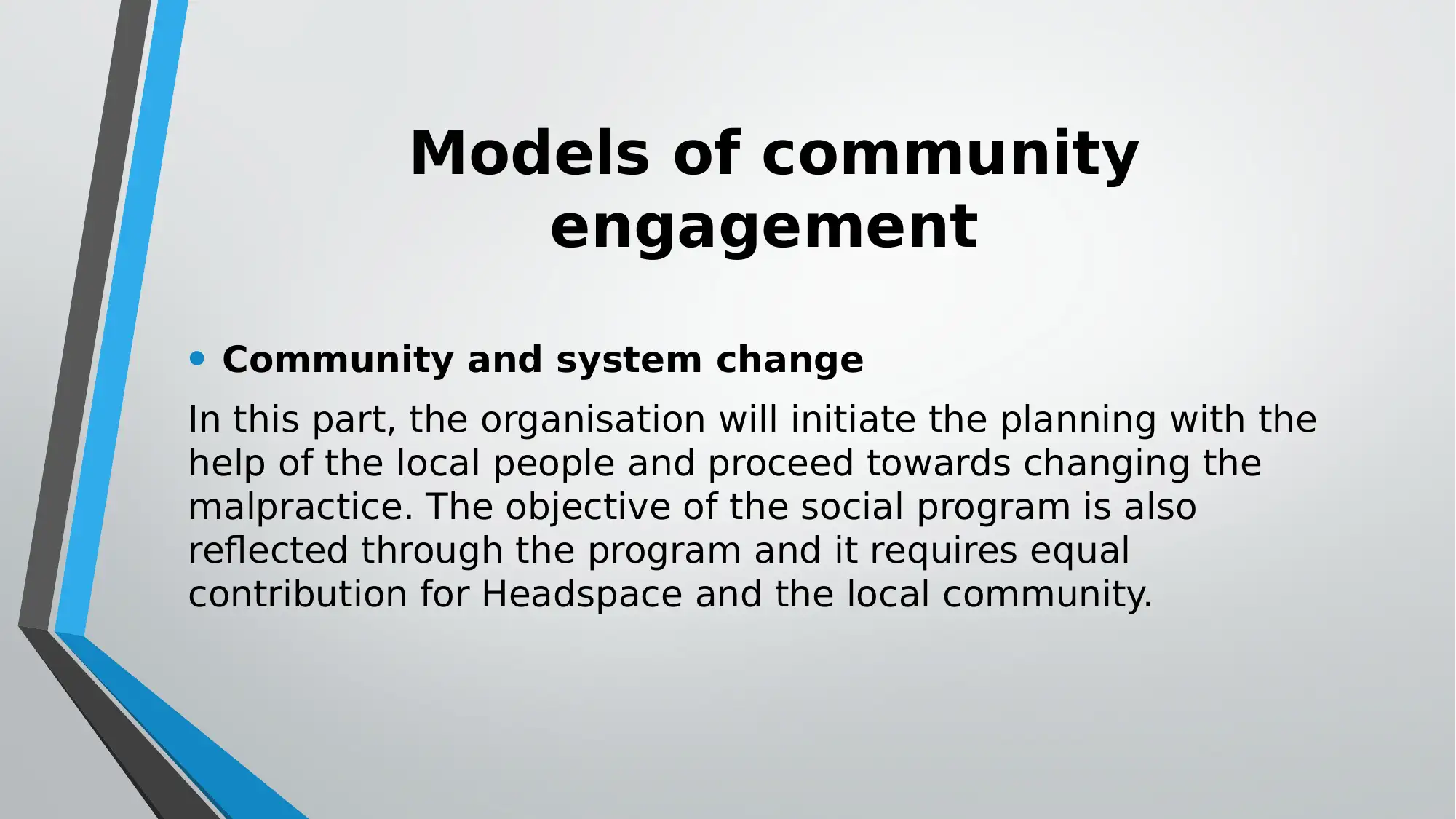
Models of community
engagement
• Community and system change
In this part, the organisation will initiate the planning with the
help of the local people and proceed towards changing the
malpractice. The objective of the social program is also
reflected through the program and it requires equal
contribution for Headspace and the local community.
engagement
• Community and system change
In this part, the organisation will initiate the planning with the
help of the local people and proceed towards changing the
malpractice. The objective of the social program is also
reflected through the program and it requires equal
contribution for Headspace and the local community.
Paraphrase This Document
Need a fresh take? Get an instant paraphrase of this document with our AI Paraphraser
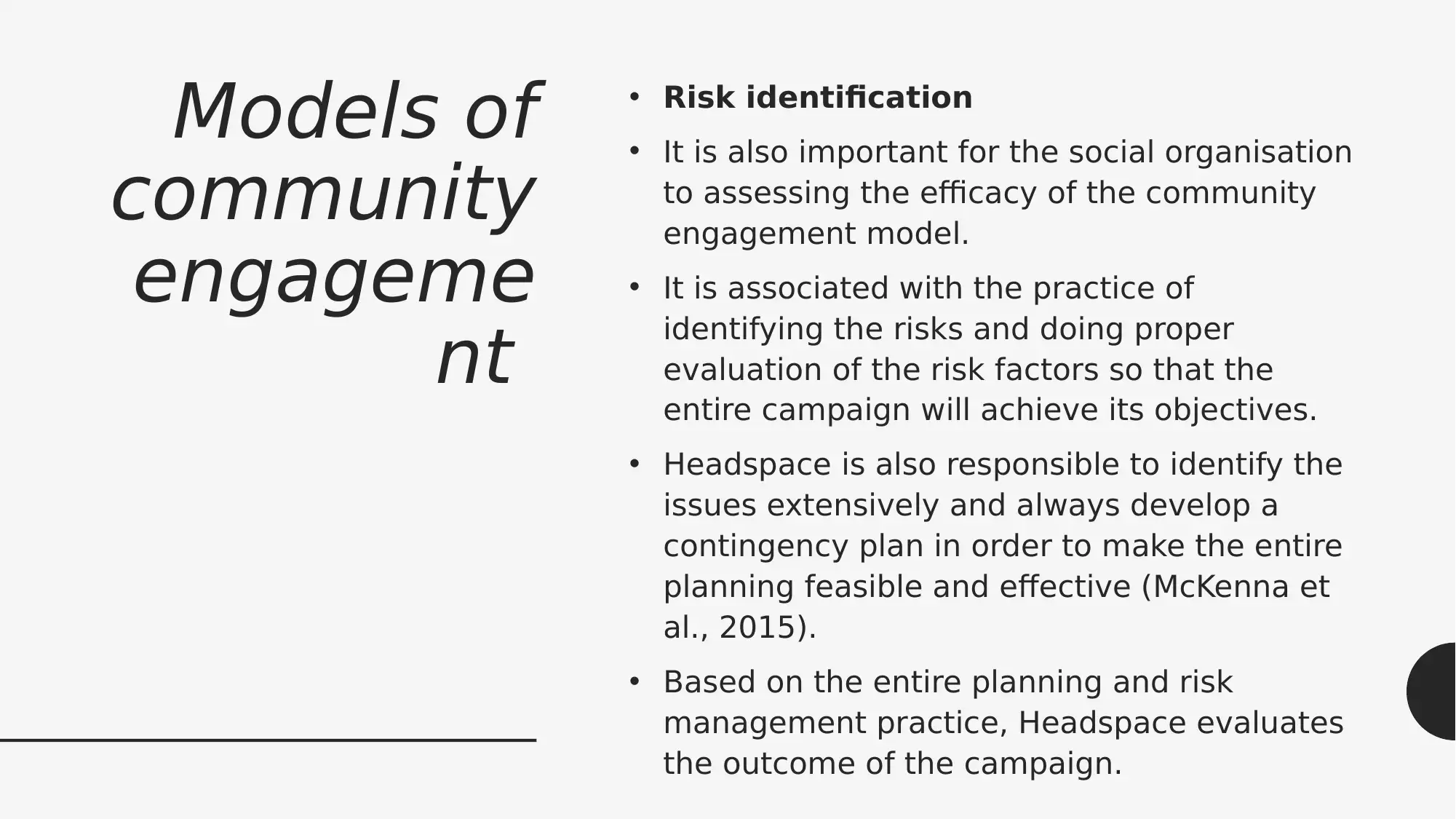
Models of
community
engageme
nt
• Risk identification
• It is also important for the social organisation
to assessing the efficacy of the community
engagement model.
• It is associated with the practice of
identifying the risks and doing proper
evaluation of the risk factors so that the
entire campaign will achieve its objectives.
• Headspace is also responsible to identify the
issues extensively and always develop a
contingency plan in order to make the entire
planning feasible and effective (McKenna et
al., 2015).
• Based on the entire planning and risk
management practice, Headspace evaluates
the outcome of the campaign.
community
engageme
nt
• Risk identification
• It is also important for the social organisation
to assessing the efficacy of the community
engagement model.
• It is associated with the practice of
identifying the risks and doing proper
evaluation of the risk factors so that the
entire campaign will achieve its objectives.
• Headspace is also responsible to identify the
issues extensively and always develop a
contingency plan in order to make the entire
planning feasible and effective (McKenna et
al., 2015).
• Based on the entire planning and risk
management practice, Headspace evaluates
the outcome of the campaign.
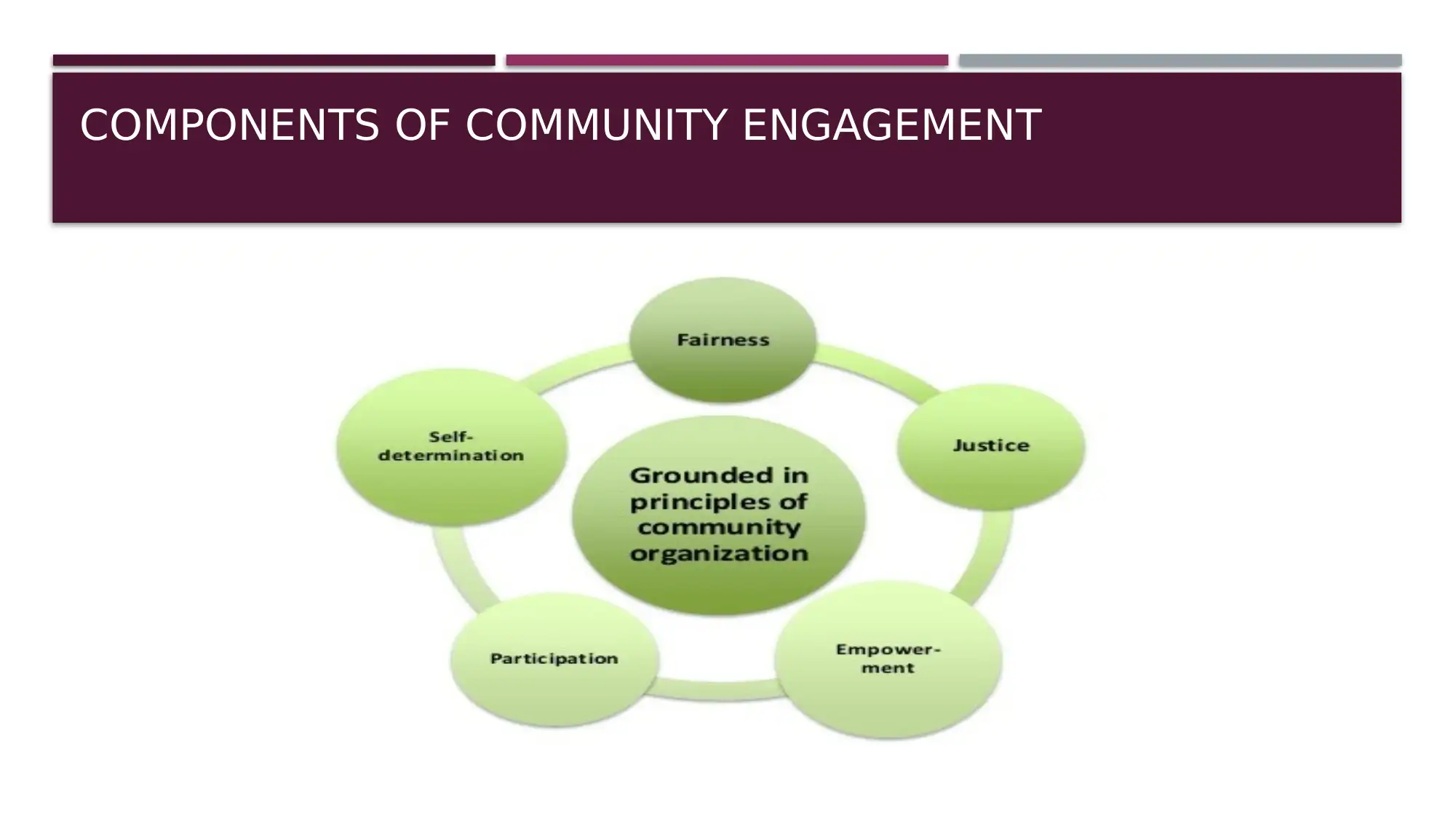
COMPONENTS OF COMMUNITY ENGAGEMENT
⊘ This is a preview!⊘
Do you want full access?
Subscribe today to unlock all pages.

Trusted by 1+ million students worldwide
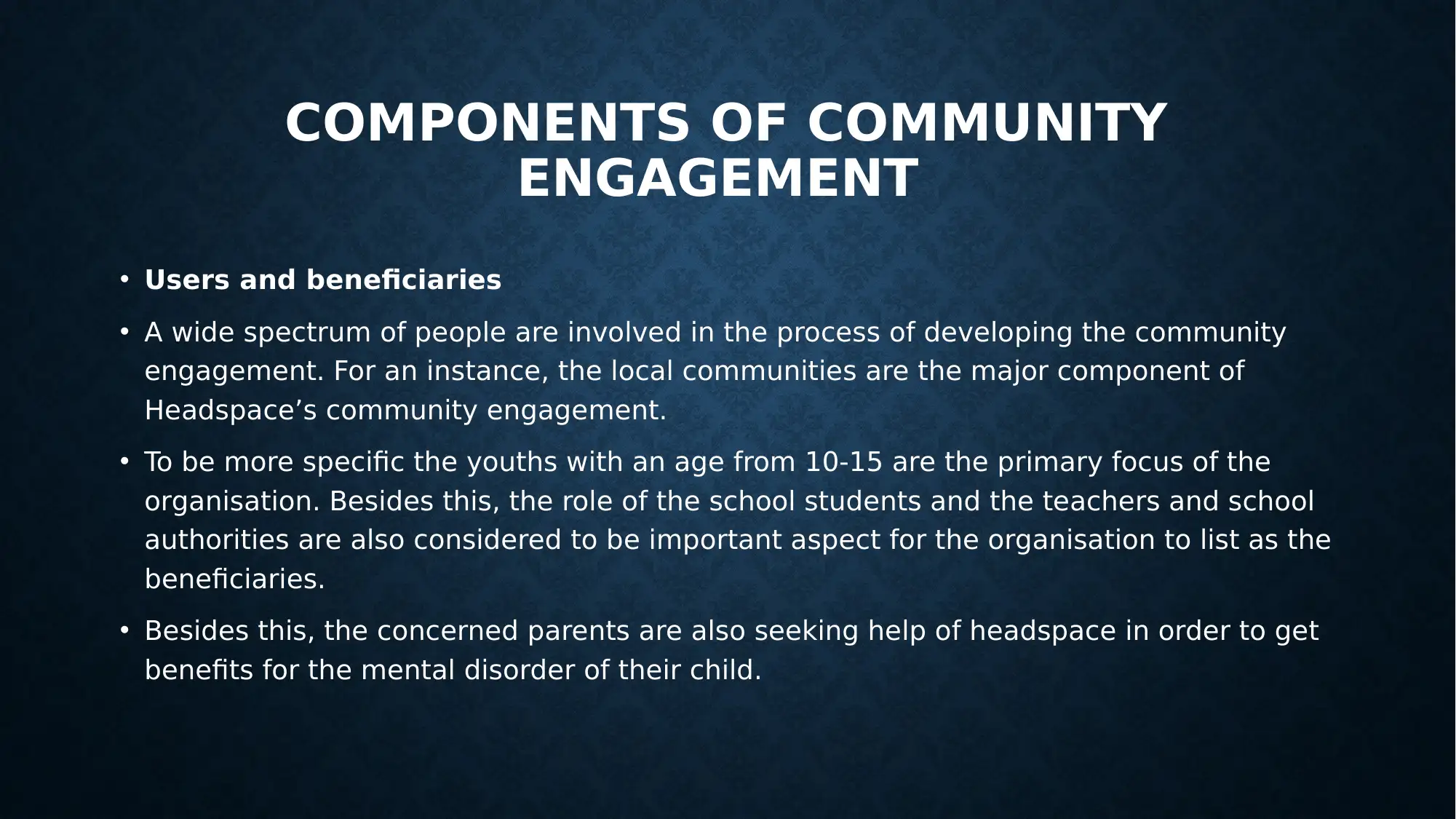
COMPONENTS OF COMMUNITY
ENGAGEMENT
• Users and beneficiaries
• A wide spectrum of people are involved in the process of developing the community
engagement. For an instance, the local communities are the major component of
Headspace’s community engagement.
• To be more specific the youths with an age from 10-15 are the primary focus of the
organisation. Besides this, the role of the school students and the teachers and school
authorities are also considered to be important aspect for the organisation to list as the
beneficiaries.
• Besides this, the concerned parents are also seeking help of headspace in order to get
benefits for the mental disorder of their child.
ENGAGEMENT
• Users and beneficiaries
• A wide spectrum of people are involved in the process of developing the community
engagement. For an instance, the local communities are the major component of
Headspace’s community engagement.
• To be more specific the youths with an age from 10-15 are the primary focus of the
organisation. Besides this, the role of the school students and the teachers and school
authorities are also considered to be important aspect for the organisation to list as the
beneficiaries.
• Besides this, the concerned parents are also seeking help of headspace in order to get
benefits for the mental disorder of their child.
Paraphrase This Document
Need a fresh take? Get an instant paraphrase of this document with our AI Paraphraser
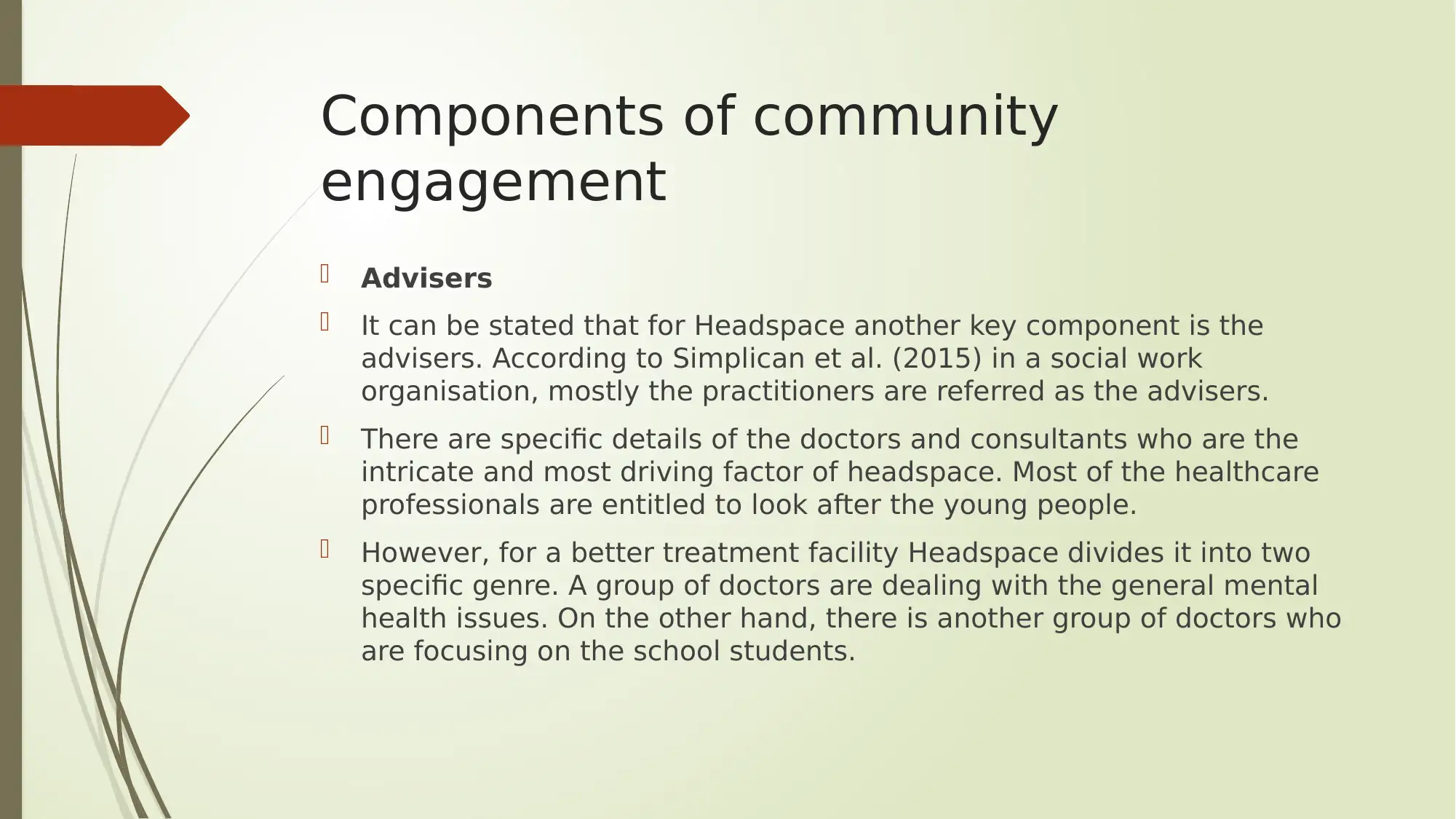
Components of community
engagement
Advisers
It can be stated that for Headspace another key component is the
advisers. According to Simplican et al. (2015) in a social work
organisation, mostly the practitioners are referred as the advisers.
There are specific details of the doctors and consultants who are the
intricate and most driving factor of headspace. Most of the healthcare
professionals are entitled to look after the young people.
However, for a better treatment facility Headspace divides it into two
specific genre. A group of doctors are dealing with the general mental
health issues. On the other hand, there is another group of doctors who
are focusing on the school students.
engagement
Advisers
It can be stated that for Headspace another key component is the
advisers. According to Simplican et al. (2015) in a social work
organisation, mostly the practitioners are referred as the advisers.
There are specific details of the doctors and consultants who are the
intricate and most driving factor of headspace. Most of the healthcare
professionals are entitled to look after the young people.
However, for a better treatment facility Headspace divides it into two
specific genre. A group of doctors are dealing with the general mental
health issues. On the other hand, there is another group of doctors who
are focusing on the school students.
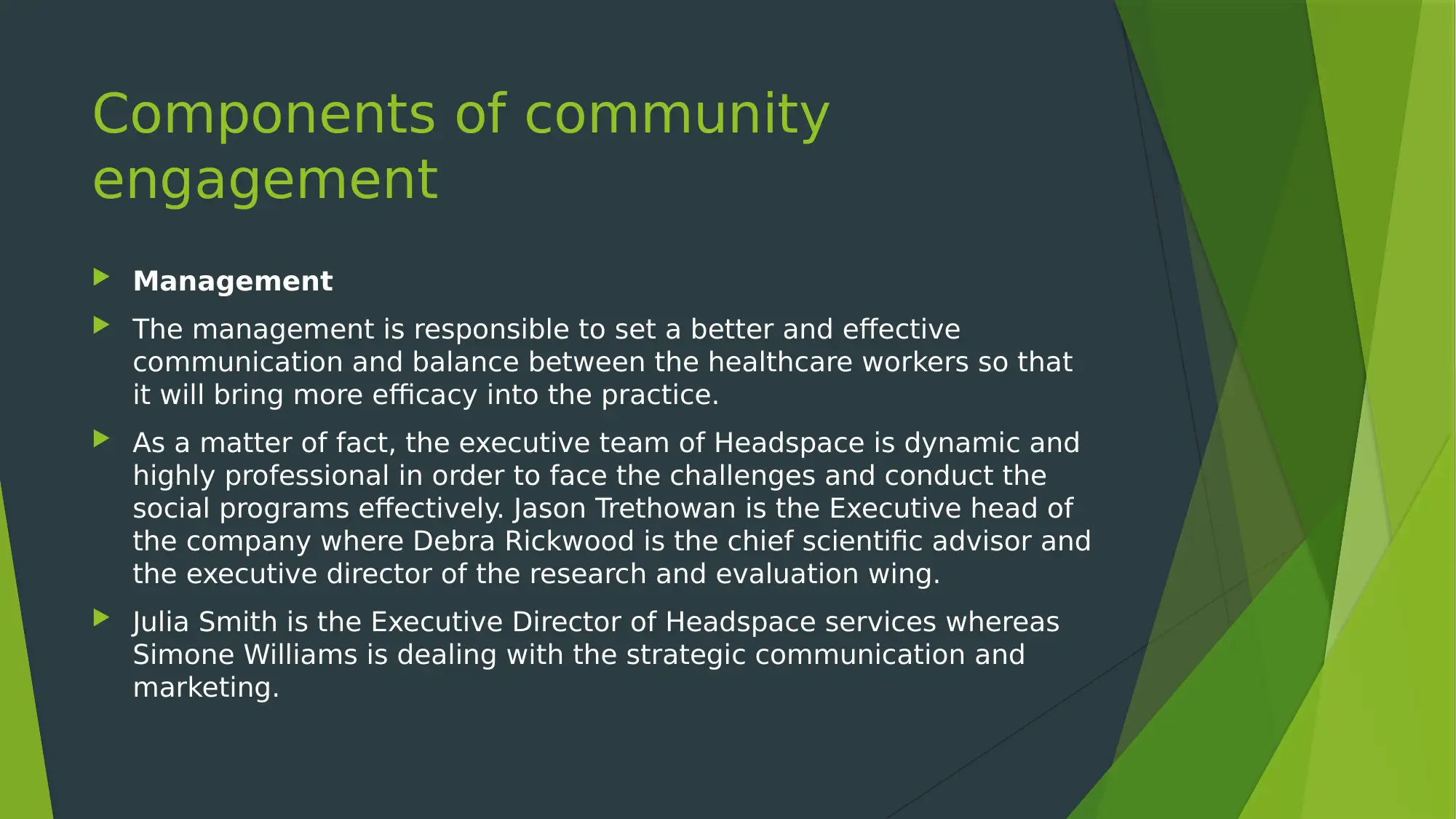
Components of community
engagement
Management
The management is responsible to set a better and effective
communication and balance between the healthcare workers so that
it will bring more efficacy into the practice.
As a matter of fact, the executive team of Headspace is dynamic and
highly professional in order to face the challenges and conduct the
social programs effectively. Jason Trethowan is the Executive head of
the company where Debra Rickwood is the chief scientific advisor and
the executive director of the research and evaluation wing.
Julia Smith is the Executive Director of Headspace services whereas
Simone Williams is dealing with the strategic communication and
marketing.
engagement
Management
The management is responsible to set a better and effective
communication and balance between the healthcare workers so that
it will bring more efficacy into the practice.
As a matter of fact, the executive team of Headspace is dynamic and
highly professional in order to face the challenges and conduct the
social programs effectively. Jason Trethowan is the Executive head of
the company where Debra Rickwood is the chief scientific advisor and
the executive director of the research and evaluation wing.
Julia Smith is the Executive Director of Headspace services whereas
Simone Williams is dealing with the strategic communication and
marketing.
⊘ This is a preview!⊘
Do you want full access?
Subscribe today to unlock all pages.

Trusted by 1+ million students worldwide
1 out of 18
Related Documents
Your All-in-One AI-Powered Toolkit for Academic Success.
+13062052269
info@desklib.com
Available 24*7 on WhatsApp / Email
![[object Object]](/_next/static/media/star-bottom.7253800d.svg)
Unlock your academic potential
Copyright © 2020–2025 A2Z Services. All Rights Reserved. Developed and managed by ZUCOL.




